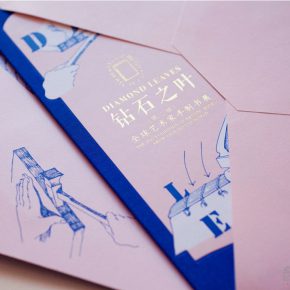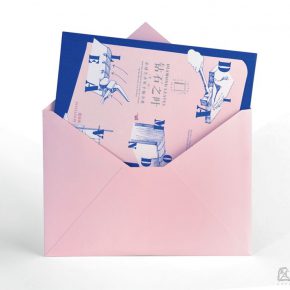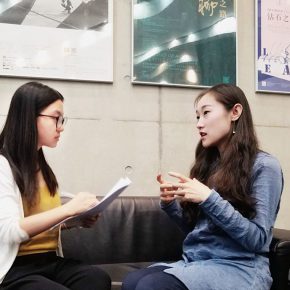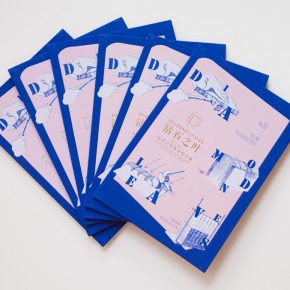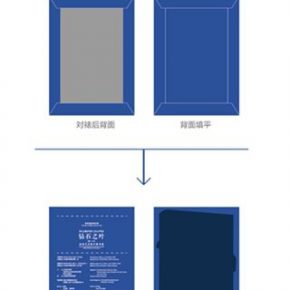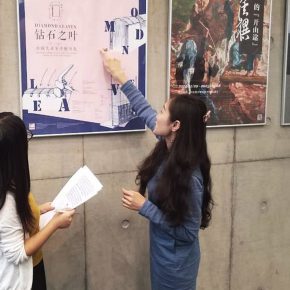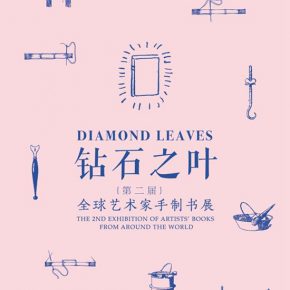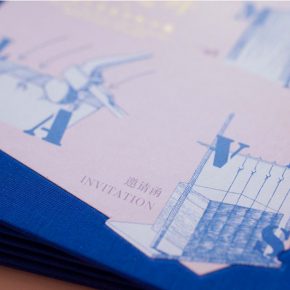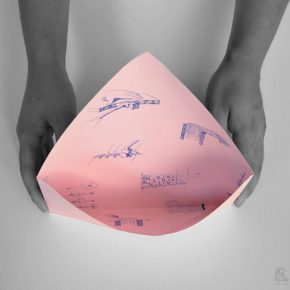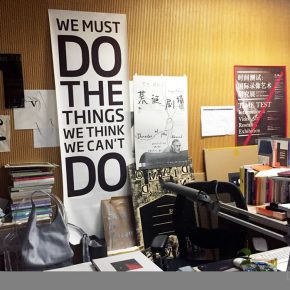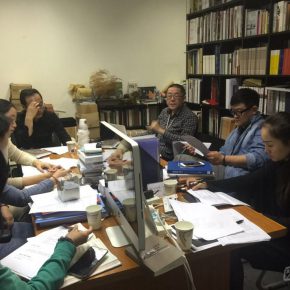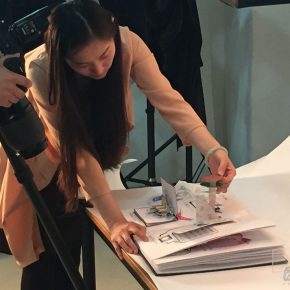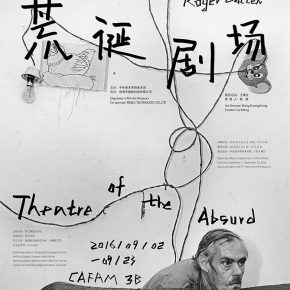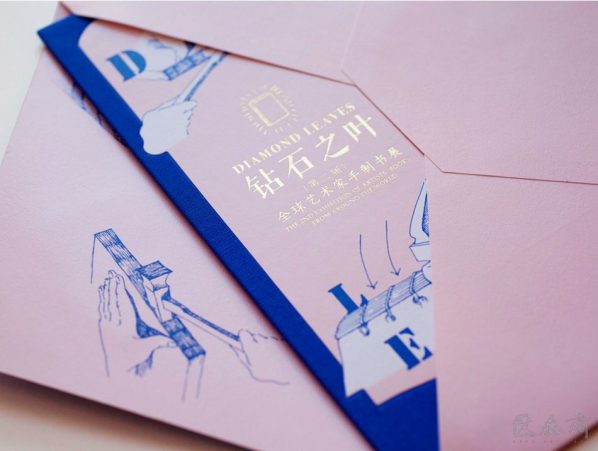
Hosted by PIA, the Benny Award began in 1952, it was named after Benjamin Franklin, nickname Benny, the inventor who brought a revolutionary development to the technology of the American printing industry, it is the most authoritative and influential competition on printed matters, known as the “Oscar” of the printing industry throughout the world.
In the competition of the 67th Benny Award held in June, 2016, the Certificate of Merit was awarded to the invitation from the art exhibition which has aroused widespread interest in the industry and the winner is the design by Ji Yujie who is the Visual Director of the Department of Exhibition at the CAFA Art Museum. The invitation was designed for the “Diamond Leaves” the Second Exhibition of Artists’ Books from around the World in 2015, which was jointly organized by CAFA, Chelsea College of Art and Design at the University of the Arts London, and Artron Culture Group, jointly curated by the artist Xu Bing and Chris Wainwright, and the invitation was printed by Artron Culture Group. CAFA ART INFO interviewed Ji Yujie, the designer of the invitation and the image system designer of “Diamond Leaves” on related issues.
Interview Time: September 18, 2016
Interview Location: CAFA Art Museum Café
Interviewee: Ji Yujie (hereinafter referred to as “Ji”)
Interviewer and Editor: Zhang Yizhi
Translated by Chen Peihua and edited by Sue/CAFA ART INFO
Congratulations on your design work of an invitation “Diamond Leaves” which won the Benny Award. From your perspective, why it is highly praised by the industry? Is this a surprise for you?Ji: Thank you, I am surprised that this invitation won a prize. I remember that Michael Makin, a judge of the award, CEO and President of the PIA once told a journalist the rules of the award: “... we compare and assess based on the product’s quality, artistry and aesthetic perception.” From this perspective, this invitation was awarded because of two key factors: Firstly, it is clearly a sophisticated printing process for the invitation, secondly it is an invitation design which transmits artistry and aesthetic perception.
Although it is called the printing prize, “design” is the first step in the creation of the finished product, leading to the final result of the invitation. The perfect idea is combined with sophisticated technology, as well as the smooth communication between the designer and producer which directly affects the result of the work, can you share with us how you cooperate with the printing company?Ji: I first cooperated with Artron Company when I was still a student of CAFA, and after I graduated with a master’s degree in 2010, I entered the CAFA Art Museum and became engaged in design and then frequently cooperated with Artron. We have a perfect cooperation, because Artron uses high-quality printing and the ability to be the keenest to absorb and express new materials, newcrafts and new technology; on the other hand, the professionalism and experimental spirit of Artron business specialists, who have good communication skills and willingness to help designers to have experiments on the process, helping designers to achieve the ideal design.
As an experienced designer, can you further talk about what you think of relations between design and printing?Ji: The relationship between Design and printing is complementary. Designers should equally emphasize the printing and early creative design. A perfect printing production is created after experiencing many processes, including design creativity, design finishing, proof testing, plate making, printing, craft production, all covering a wide professional level. Therefore, as a designer, one does not only have a solid modeling basis and an high-level aesthetic ability, but also a comprehensive understanding of printing materials, printing technology, ink, crafts, etc.
How did you find inspiration at that time?Ji: Xu Bing was the curator who carefully guided and gave me freedom to develop, from the big subject concept of image design to the minor tasks of choosing of colors which have a 5% chromatic aberration, considering everything and all kinds of work; at the same time, in order to help me to have a better understanding of printmaking language, Xu also gave his collection: the printmaking magazine “SPEKTRUM” to me as a reference, under the guidance of Xu, the visual image of the exhibition was smoothly and perfectly finished.
“Diamond Leaves” the Second Exhibition of Artists’ Books from around the World emphasized the “hand-made”, and the sense of “craftsmen”; to present 4 types of manufacturing processes of hand-made books by etching illustrations, thus forming the main visual image of the exhibition. The hand-drawn illustrations and hand-made books both emphasis handwork, while prints are closely related to the printing style of books, so it is sufficient to use prints to express handmade books.
We have noticed that this invitation and the visual design of the whole exhibition adopted a combination of royal blue and light pink, formally joining the very detailed hand-drawn illustrations, applying the forms of silver pressing, cloth mounting, patching, etc., can we introduce these elements and the reasons why you chose them?Ji: I chose these two colors as the consideration of visual continuity of the series of exhibitions, the color system of the First Diamond Leaves consists of blue, pink and light gray (auxiliary color), while the second Diamond Leaves applied magenta as the auxiliary color, so that the color of the series of exhibitions is changeable in the unity. In order to pursue the calligraphic style of the screen, I invited He Shiyi from the Department of Printmaking and Sun Tong from the School of Design to assist with finishing the etching textural illustrations. It applied a variety of crafts including mounted board, die-cutting, patching, gold foil, filling, etc., the use of many complex skills and it is full of details.
Will you estimate the ultimate effect of the product during the conceptual stage? Is the final product distant from the envisioned idea?Ji: I had a forecast of the final product of the invitation but it was a combination of a variety of crafts, so that I could not completely guarantee it, and I also discussed the effects together with other members of the design team, and Artron finally presented a high quality invitation with the details and handwork, which made the finished product beyond the preliminary preconception.
Ji Yujie has worked in the Department of Exhibition, CAFA Art Museum for 6 years, together with other designers to finish the visual designs of a variety of exhibitions in different sizes, including “Memorial Exhibition for the One Hundredth Anniversary of Luo Gongliu’s Birth” and “Roger Ballen: Theater of the Absurd” both of which have attracted wide attention and praise. Through this opportunity, we invite Ji Yujie to simply share her results, ideas and experiences of a visual system design from the museum exhibitions.
What experience did you encounter when engaged in the visual design of CAFA Art Museum?Ji: I think it is “unfortunate” to be engaged in the visual design of a museum, but it is “fortunate” to be a designer in CAFA Art Museum. It is the era of “exhibition”, and the exhibitions are developing at an unprecedented rate in China at present, a domestic art museum will present exhibitions ten times more than foreign art museums of the same type. The majority of domestic exhibitions want things done urgently with heavy tasks, overtime and staying up late as the norm, the most Chinese characteristic is the “modification”, designers become executors of curators’ intentions, so the limitations of designers is obvious. Why do I feel “fortunate” to serve as a designer in CAFA Art Museum? Firstly, it is a young museum, when I graduated and worked in the museum in the summer of 2010, it was only two years old, a variety of works were in need of rules and regulations, including the design of the museum, it was short of a design “style” or “temperament” of the academy museum’s features at that time, which gave designers space for exploration and a chance to develop freely; secondly, under the leadership of Director Wang Huangsheng, the museum has established an academic, freedom, open position, he has established an exhibition sequencefor CAFA’s features, resulting in strong academic exhibitions offer designers high-quality creative soils.
From your perspective, after dealing with a variety of visual designs for exhibitions, how do you find a perfect visual information style for the presentation for different featured exhibitions?Ji: How to exactly and fully express the theme of the exhibition is a lifelong proposition for me. If the process of exhibition design is dismantled, they can be: “Understanding + Design (Conversion) + Execution.” In addition, designers also need to have macro-control ability, grasping the visual qualities of different types of exhibitions. CAFA’s exhibitions are divided into several types through the content, because they have different contexts, the temperaments should be segmented. The series of biennales are avant-garde, flexible; International communication exhibitions emphasize the individuality and specifics; exhibitions of masters reflect the generosity and solemnity; exhibitions of collections reflect the refinement, elegance and sense of history; teaching exhibitions might be relatively simple and academic. Overall, they refuse to deviate from the academic and research qualities advocated by CAFA.
As an expression the design is derived from the understanding of the individual. Most of designers encounter the problem that balances the relationship between the individual freedom of creation and work requirements, have you been faced with similar problems and challenges? How did you resolve them?
Ji: Designers can’t take an exhibition design as a tool to express the self-design style, they can make use of a subject to elaborate their own ideas, but it is not overwhelming, designers are always balancing the conflict and contradiction between the creation and demand, each exhibition is a selfish game process.
Do you have your own habitual state when you are designing, or what state do designers who solve design problems have?Ji: “Fighting for a breakthrough in each design” can be considered my principle to deal with design, such breakthroughs can be in the visual form, materials or workmanship, the most important thing is to break the mindset, experiences can help me to make a judgment, but I can’t use experiences and the inertia to think. I am also willing to try the “cross-thinking of design”, constantly broadening my own interdisciplinary knowledge structure, in the frame of design ideas to fill the related knowledge on art history, museums, curating, sociology, etc., to make my design ideas more widespread.
The Benny Award hold an award ceremony in Orlando, USA on September 25.


